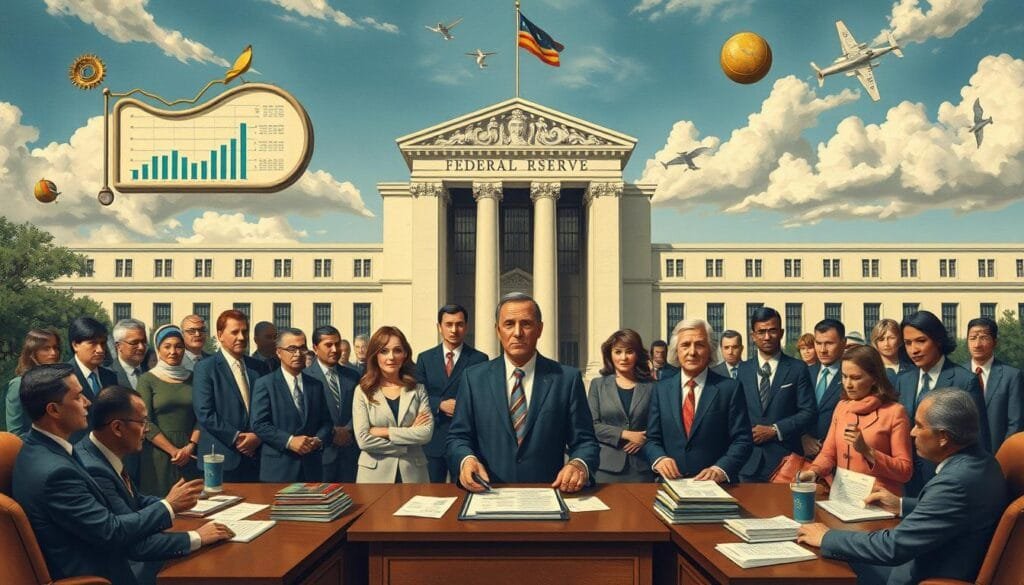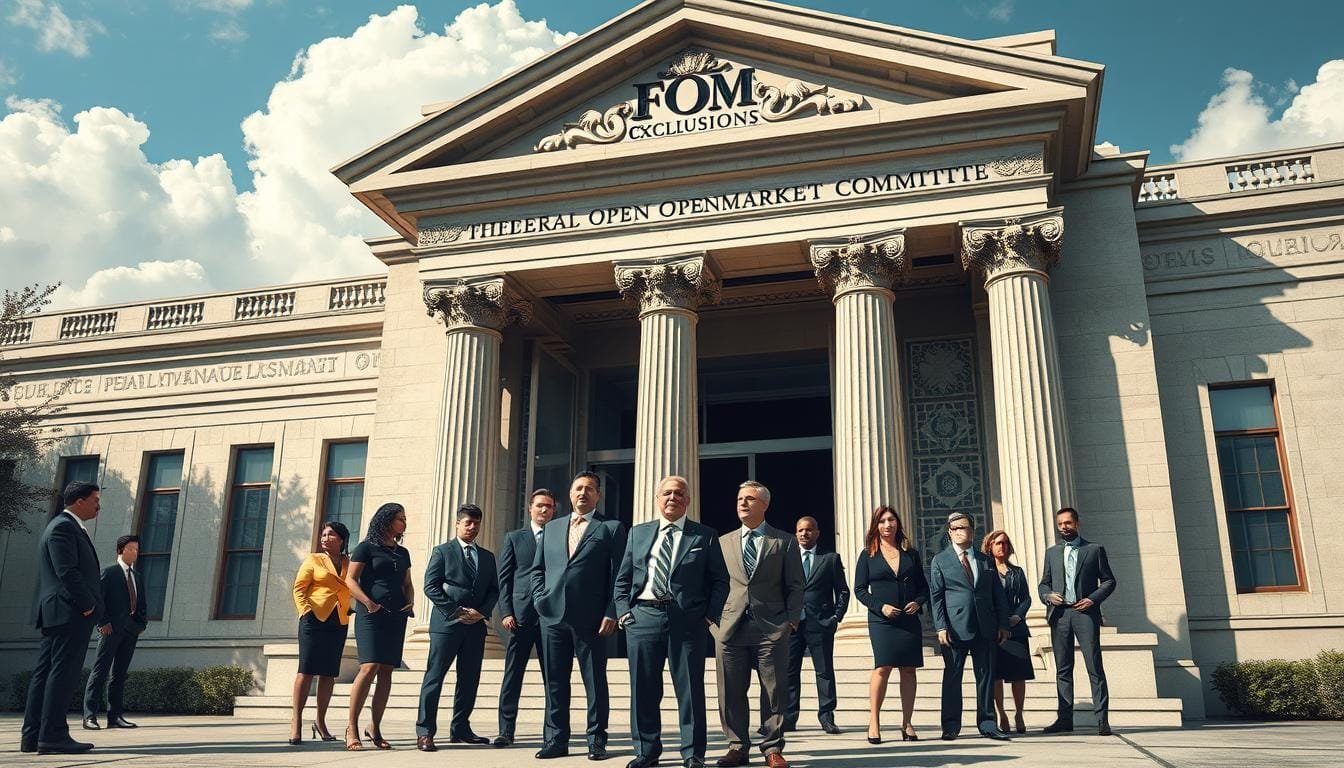Have you ever thought about why some key economic figures aren’t in the Federal Open Market Committee? We’re going to dive into the inner workings of the Federal Reserve’s decision-makers. We’ll see why some are outside this group.
Learning about Federal Reserve non-members shows us the power play in U.S. economic policies. The FOMC plays a big role in setting monetary policy. But it’s also important to note who is not included.
Let’s explore the influence of economic policy outsiders on the American economy.
We’ll look into who is missing from the FOMC. This helps us understand all the different forces at work in economic policy-making. It shows how varied influences shape our financial future.
Key Takeaways
- The FOMC comprises 12 members: 7 board governors, 1 New York Fed president, and 4 regional Reserve Bank presidents.
- FOMC meetings occur about every six weeks, totaling approximately 8 meetings per year.
- Four regional bank presidents rotate annually in voting positions.
- Inflation rates rose to the highest level since the 1980s, influencing the decision to increase interest rates.
- All reserve bank presidents, whether voting or not, contribute to the Committee’s assessment of the economy.
Introduction to the FOMC
The Federal Open Market Committee (FOMC) plays a key role in the Federal Reserve System. It came to be during the Banking Acts of 1933 and 1935. The FOMC steers open market operations and shapes monetary policy for economic stability.
Its goals are to boost job numbers and keep prices stable. Knowing about the FOMC’s tasks, Federal Reserve policy, and its impact on our economy helps us see its value.
Overview of FOMC Purpose
The FOMC’s main job is to handle open market operations. These actions affect the overnight lending rates between banks. By adjusting the federal funds rate, the committee works to keep inflation in check and promote growth.
They meet eight times a year to fine-tune interest rates and policy. In 2008, they met 14 times to guide us through economic challenges.
FOMC Membership Composition
The FOMC is made up of 12 voting members. Seven are from the Board of Governors and five are Reserve Bank presidents. The New York Reserve Bank president always has a seat, while four others rotate from the 11 other Banks.
This rotation method makes sure all regions are heard over time. It helps the FOMC reflect both regional and national monetary strategies.
- Board of Governors (7 members, permanent)
- Federal Reserve Bank of New York President (permanent)
- Four rotating Reserve Bank presidents selected yearly from different districts.
The FOMC members play a critical role in our country’s economy. Together, they tackle complex economic issues to promote growth and stability.
The Structure of the FOMC
The Federal Open Market Committee (FOMC) is the monetary policy-making body of the Federal Reserve. Understanding the FOMC structure is key to knowing how the Federal Reserve governance works. It shapes decisions that impact the U.S. economy.
Board of Governors
The Board of Governors holds significant power within the FOMC structure. It has seven members, including roles like a Chair and Vice-Chair. Their decision-making greatly influences economic policies.
These members are picked by the President and approved by the Senate. This process ensures a mix of political oversight and economic stability. Governors serve for 14 years. This approach keeps the board steady over time. The Chair and Vice-Chair, appointed for four years, can be chosen again. This underlines the value of having leaders with vast experience in monetary policy.

Federal Reserve Bank Presidents
The governance includes presidents from the 12 Reserve Banks. Monetary policy makers from these banks are crucial in shaping policies. The group includes the New York Reserve Bank’s president, who always has a seat. Four other presidents join on a rotating basis each year.
These five, together with the Board’s seven governors, form the 12-member FOMC. This setup ensures diverse viewpoints in policymaking. They look after different regions and bring varied perspectives to the table.
| FOMC Member | Number | Terms |
|---|---|---|
| Board of Governors | 7 | 14 years, staggered |
| Federal Reserve Bank Presidents | 5 (includes NY) | 1 year, rotating |
The thorough FOMC structure guarantees many opinions are considered. This strengthens the Federal Reserve’s monetary policies. It improves their response to economic hurdles effectively.
Who Is Not Part of the FOMC in Economics
Understanding non-FOMC members in economics sheds light on the Federal Open Market Committee’s (FOMC) dynamics. It’s important to recognize the impact of those without voting rights on U.S. monetary policy.
The FOMC includes twelve members, but key economic figures lack voting rights. Notably, certain regional Federal Reserve Bank presidents rotate in voting positions. These include presidents from cities like Boston, Philadelphia, and San Francisco.
Even though they can’t vote, these non-FOMC members are critical in discussions. They provide insights that shape Federal Reserve exclusions. Their input ensures diverse regional views are considered during deliberations.
The impact of these economic influencers without FOMC membership is significant. They add valuable regional information and viewpoints to the committee. Their non-voting role doesn’t lessen their influence on the FOMC’s views on economic and financial conditions.
Nonvoting Reserve Bank presidents rotate annually from banks including:
- Boston, Philadelphia, and Richmond
- Cleveland and Chicago
- Atlanta, St. Louis, and Dallas
- Minneapolis, Kansas City, and San Francisco
This rotation ensures different regional leaders add to FOMC discussions. While they don’t vote, their ideas influence policy talks. They bring essential economic information from their regions.
Their input highlights the importance of nonvoting members in the Federal Reserve’s mechanism. By including their views, the FOMC makes more informed policy decisions. This approach takes into account the national economic landscape.
The Role of Nonvoting Members
Not all regional Federal Reserve Bank presidents can vote in the Federal Open Market Committee (FOMC). Yet, the importance of FOMC nonvoting roles is key. Nonvoting members join FOMC meetings and greatly shape dialogue and policy plans. Including Reserve Bank presidents, they offer economic consultation. They bring insights from their regions.
Even without vote power, nonvoting members hold great influence in FOMC talks. They ensure that U.S. monetary policy reflects different economic conditions nationwide. Their insights and data make a full picture. This guides discussions on key issues like interest rates.

The FOMC uses a voting rotation system. The President of the New York Federal Reserve Bank has a permanent vote. Other Reserve Bank presidents rotate, serving in the four other voting roles for one year. Yet, seven nonvoting Reserve Bank presidents attend all meetings. They share views from their regions, adding to the debate.
This participation model shows how critical economic consultation is in the FOMC. Nonvoting members make sure decisions consider the whole U.S. economy. They bring a wide range of knowledge. This leads to more informed policy-making.
| Type of Member | Number of Members | Role in FOMC |
|---|---|---|
| Voting Members | 12 | Directly decide monetary policy |
| Nonvoting Members | 7 | Contribute to discussions and provide regional insights |
The impact of FOMC nonvoting roles is in giving key regional data and views. This ensures balanced and informed policy decisions for the nation. Even without voting rights, their role shows FOMC’s dedication to inclusive economic talks.
Exclusions and Their Implications
The Federal Open Market Committee (FOMC) plays a crucial role in U.S. monetary policy. However, not every region and economic advisor gets to contribute equally. This part looks into what it means when some are left out. It focuses on regions not represented in the Federal Reserve. Also, it discusses the absence of key economic advisory roles from the voting process.
Regions Not Represented Each Year
Every year, certain Federal Reserve regions don’t have a vote in the FOMC. These areas face special challenges. Their economic conditions and concerns might go unnoticed in national policy-making. This can ignore regional economic needs in larger decisions.
In 2024, the unemployment rate went up to 4.2% in November. The job vacancy to unemployment ratio stayed at 1.1. While these numbers show the country’s economic health, they might not tell the full story for areas left out. This can lead to national policies that don’t fit every region. So, it’s crucial for the FOMC to aim for fairer representation.

Economists and Advisors
Diverse economic advisors are key to the FOMC’s policy-making. Yet, some important economists and advisors aren’t included in the voting. This can narrow the range of views considered. Not having certain advisors affects the FOMC’s understanding of complex economic issues across demographics.
| Economic Indicator | 2023 | 2024 |
|---|---|---|
| Total Consumer Price Inflation (PCE) | 3.0% | 2.3% |
| Core PCE Price Inflation | 3.4% | 2.8% |
| 12-Month Change in CPI | 3.3% | 2.7% |
| Unemployment Rate | 4.1% | 4.2% |
For instance, average hourly earnings for employees rose 4% by November 2024. Input from labor economists could help in understanding wage changes. Advisors with knowledge of financial inclusion could highlight how certain areas suffer more.
The lack of diverse FOMC advisors leads to policies that might overlook various U.S. economic situations. It’s important to work on including more voices for better monetary policies.
Conclusion
We’ve looked into the key aspects of the Federal Open Market Committee’s setup and decision-making. The decentralized nature of the U.S. central bank includes the Board of Governors and a rotating group of regional Federal Reserve Bank presidents. This ensures a broad view of regional economies is considered in policy making.
The excluded entities and individuals from the FOMC are still crucial. They may not vote, but their insights and analyses are essential. Nonvoting members and advisors help understand important economic indicators. Indicators like GDP growth, inflation, and unemployment figures, influencing the Federal Reserve’s broader strategies.
Knowing how Federal Reserve exclusions work is key to understanding economic policy impacts. The interaction between voting and nonvoting members, along with advice from various economic advisors, forms a complex yet effective system for shaping monetary policies. This ensures that, even without a vote, the perspectives of certain regions or individuals significantly influence the Federal Reserve’s objectives and actions. This impacts interest rates, inflation targets, and broader U.S. economic policies.
FAQ
What is the purpose of the FOMC?
The FOMC handles open market operations in the U.S. Its main goals are to manage monetary policy to ensure jobs are plentiful, prices are stable, and interest rates are moderate.
Who is included in the FOMC membership composition?
The FOMC consists of the Board of Governors of the Federal Reserve and five of the regional Federal Reserve Bank presidents. The Board of Governors Chair usually chairs the FOMC too.
How is the structure of the FOMC organized?
At the heart of the FOMC are the Board of Governors, chosen by the U.S. President. There are also five Federal Reserve Bank presidents who rotate annually from the twelve regional Banks.
Who are the members of the Board of Governors?
There are seven members on the Board of Governors. They are appointed by the President and approved by the Senate. These members play a key role in national monetary policy and managing the Federal Reserve Banks.
What role do the Federal Reserve Bank presidents play?
Federal Reserve Bank presidents represent their regions at FOMC meetings. They are vital for bringing various economic views from their areas, impacting monetary policy decisions.
Who is not a part of the FOMC in economics?
Individuals outside the direct monetary policy group, like economists and advisors, don’t partake in the FOMC. They don’t vote but might share insights, without voting rights.
What is the role of nonvoting members in the FOMC?
Nonvoting members, including some Federal Reserve Bank presidents, don’t vote on decisions but still share their knowledge. They provide key regional and economic advice.
Which regions are typically not represented each year in the FOMC?
Every year, some Federal Reserve districts might not be represented in the FOMC since presidents rotate. However, these districts still take part in discussions.
Are economists and advisors part of the FOMC?
Economists and advisors aren’t formal FOMC members, but their advice is crucial. They offer in-depth analyses that help guide the committee.
